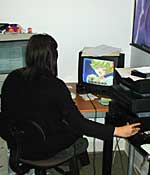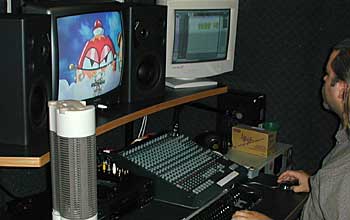
by Luis Reyes
|
"We wanted to get it out ASAP, because we wanted a product ASAP," Sheh explains. "So instead of recording the whole series first, all 26 episodes, and then going into post production, we're recording it volume by volume. And after each volume is complete, we're going to release it."
However, in the haste to release "Tenshi ni Narumon," several small mistakes blemish Synch-Point's inaugural work. In the mad post-production rush, production staff forgot to take the VHS dub version to the subtitling company, which left the closing song of each episode (in Japanese) bereft of subtitles. Conversely, the subtitled version of "Tenshi" lacks sound when the Synch-Point logo appears on screen. And in the script itself, Gabriel screams, "Let go of my sister!" to a character that isn't holding his sister. But now that the first volume has been released and Synch-Point has shown it can generate product, Sheh feels like there's less pressure to keep such a ridiculous deadline. "I don't think that anyone that works for our company wants to put out crap," Sheh says. "So I think that when it comes down to it, I would rather push back the release dates and have it be better than to have the quality suffer. The fans are going to remember the product rather than the agitation they felt over a delayed release date. So for me the quality is more important. But I also don't think we're doing anything too impossible." The rest of "Tenshi" will be released in the same way, volume by volume as the recording finishes. However, the production schedule for Synch-Point's next project, "FLCL," a six episode series about a boy dealing with adolescent angst amid a chaotic ensemble of non-sequitur characters, will, according to Sheh, be handled like most other shows are handled in the industry. The whole series will undergo each step in succession - all the translation for the six episodes will precede all of the ADR writing, which will precede the entire recording process, etc. Synch-Point's in-house recording facility empowers the company with this kind of flexibility. "Our recording studio is modestly sized," Sheh admits. "But if we didn't have our own recording facility, we would have to rent recording time at another studio and that's quite costly. I don't want to have the director and the actors worrying about having to be out of the recording session by a certain time. I don't want them to have to think about that while they're performing. Because we have our own facility, we can accommodate for actors' schedules - late at night, early in the morning."
According to Synch-Point staff, the company has already paid for the cost of their diminuative recording studio in the amount they saved by not having to rent session time. And now that the studio is up and running, the possibility of soliciting sub-contract work to dub non-DMI titles is a part of Synch-Point's future plans. "But our production schedule is pretty hectic and our titles definitely come first," Sheh asserts. "The biggest draw back at the moment is that no one has seen anything we've done. I haven't focused on soliciting outside work because I don't have a product to present as an example of the caliber of our work." Aside from Synch-Point's lack of history, Sheh herself admits that though she's had experience behind the microphone and an extensive stage resume she's never produced for anime dubs before. |


